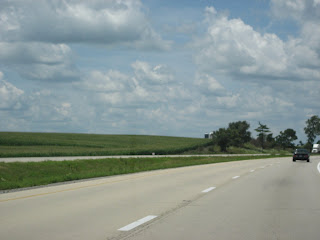
The road to Iowa: Queen Anne's lace, corn, and sky


Yes, this is Riverside, Iowa, future birthplace of Captain James T. Kirk. An enterprising (!ha ha) city councilman, in 1985, had the bright idea of asking the series' creator, Gene Roddenberry, whether Riverside couldn't call itself the "small town in Iowa" loosely designated as Kirk's birthplace. Roddenberry agreed because he felt "the first town that had volunteered ought to have it." Judging by the pace of events outlined on the Certificate of Authenticity which comes with every vial of "Kirk dirt" -- actual Riverside soil -- one may purchase at the Riverside Historical Center, approval came swiftly. The city councilman made the motion on March 25th, Roddenberry replied on the 28th and the city council passed the appropriate resolution on April 8th.

And when people come to visit, the nice volunteers ask them to put a pin in the map to show where they are from. The map of the United States is most thickly crowded with pins along a sort of Chicago-to-Riverside corridor. And the map of the world has its share. As my niece (who loathes William Shatner, for some obscure reason) put it when she saw this photo -- "holy crap."

The point of our trip, really: visiting with relatives.

A walk in the woods, Hickory Hills Park, Iowa City. "Here are the species remembered from the picnic ground, schoolhouse grove, the woodlot -- the forest preserve. Through the Northeast, across the Midwest, deciduous forest is where the people are -- or where they spent their childhood." Robert O. Petty, Deciduous Forest, 1974.

Eastbound, route 74, approaching the Mississippi. Called, always and only, the River.

That truck stop again. I-80, eastbound.

I keep waiting for the day when I am totally cool and comfortable driving the expressway. Some people actually get sleepy. I don't. If it's true that a society's greatest madness seems sane to itself, then I wonder if someday people will look back and gasp that we all considered it normal, that we made it necessary for modern life, to sit inside and maneuver large steel machines at terrifically high speeds simultaneously but orderly-like, on often crowded roads, in order to go from point A to point B in as short a time as possible. It's an exercise in sheer faith, trust in one's fellow man, that future historians will perhaps judge as far more cementing (!ha ha) to the whole society than any lessons in civics or any traditional political activity.
Physically, it's the sense of entrapment that bothers me. Next rest area, 68 miles. No way out, but more speed.

Going home.

... and say it was good.


















Great pictures, Nancy. I especially like the one with the semi-truck and red farm buildings. What a great representation of the Midwest!
ReplyDeletePat